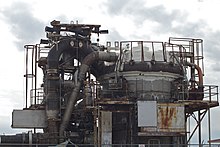avia.wikisort.org - Aeroplane
The WS-125 was an American super long-range strategic bomber project during the Cold War to develop a nuclear-powered aircraft.
| WS-125 | |
|---|---|
 | |
| A cutaway drawing of the WS-125 testbed aircraft | |
| Project for | Long-range Nuclear-powered aircraft strategic bomber |
| Requirement | WS-125 |
| Issued by | United States Air Force |
Development
In 1954, the United States Air Force (USAF) issued a weapons system requirement for a nuclear-powered bomber, designated WS-125. In 1956, General Electric teamed up with Convair (X211 program) and Pratt & Whitney with Lockheed in competitive engine/airframe development to address the requirement.[1]
In 1956, the USAF decided that the proposed WS-125 bomber was unfeasible as an operational strategic aircraft. Finally, after spending more than $1 billion, the project was canceled on March 28, 1961.[citation needed]
Powerplants


Two General Electric J87 turbofan engines were successfully powered to nearly full thrust using two shielded reactors. Two experimental engines complete with reactor systems (HTRE-3 and HTRE-1, which was modified and renamed HTRE-2) are located at the EBR-1 facility south of the Idaho National Laboratory 43°30′42.22″N 113°0′18″W. As of 2022 the reactors are still on display there.[citation needed]
See also
- Aircraft Nuclear Propulsion – U.S. project 1946–1961
- 9M730 Burevestnik (Russia)
- Planes That Never Flew, Discovery Channel
- Project Pluto – US nuclear ramjet project, 1957–1964
- Convair NB-36H – American experimental plane (1955–61)
- Convair X-6 – US proposed nuclear-powered plane (1950s)
References
- "Aviation History: The airplane that never was". www.aopa.org. January 1, 2018.
- Butler, Tony (2010). American Secret Projects. Hinckley, England: Midland Publishing. ISBN 978-1-85780-331-0.
На других языках
- [en] WS-125
[fr] WS-125
Le WS-125 était un projet de bombardier à large rayon d'action, conçu par les États-Unis durant la guerre froide. Son nom de code devait être B-72 et ce devait être un avion à propulsion nucléaire.[it] WS-125A
WS-125A (abbreviazione di Weapon System 125A, in lingua italiana Sistema d'Arma 125A) è una specifica emessa dalla United States Air Force nel novembre 1954. Tale specifica riguardava lo sviluppo di un aereo da bombardamento strategico a propulsione nucleare. Tuttavia, il requisito per il WS-125A venne cancellato nel dicembre 1956, anche se l'erogazione dei finanziamenti continuò fino al 1961.Другой контент может иметь иную лицензию. Перед использованием материалов сайта WikiSort.org внимательно изучите правила лицензирования конкретных элементов наполнения сайта.
WikiSort.org - проект по пересортировке и дополнению контента Википедии